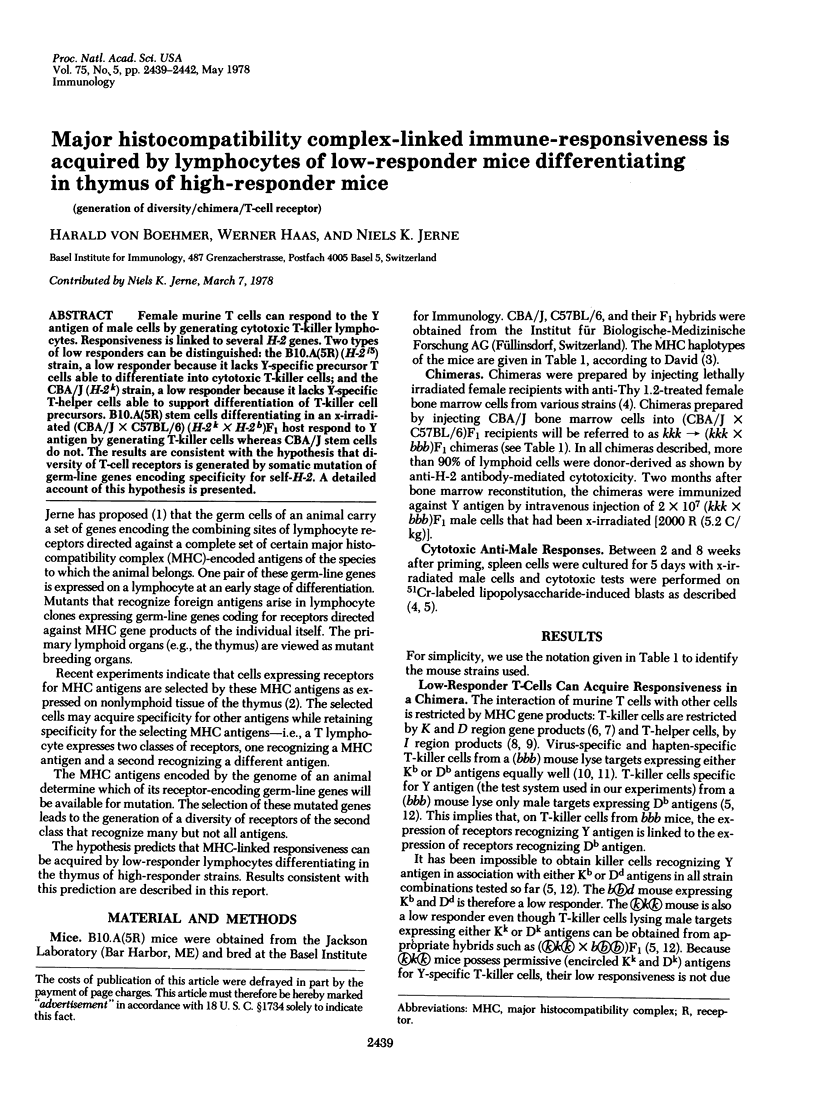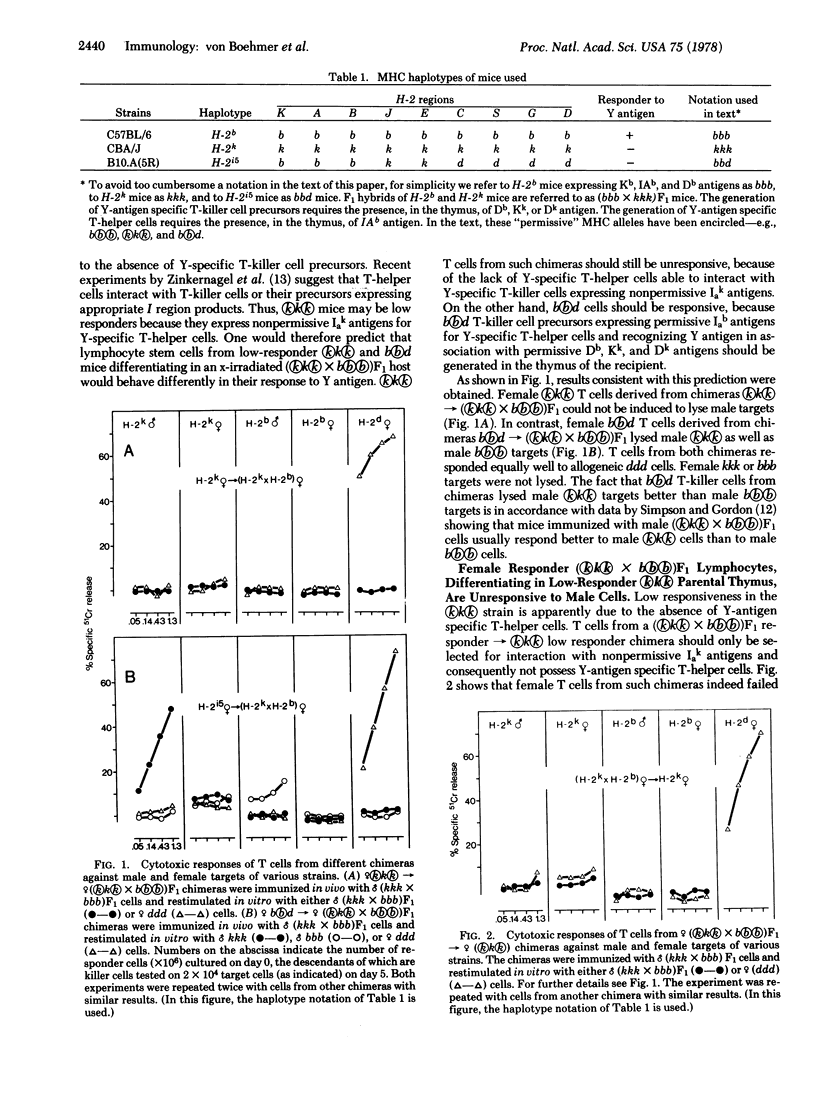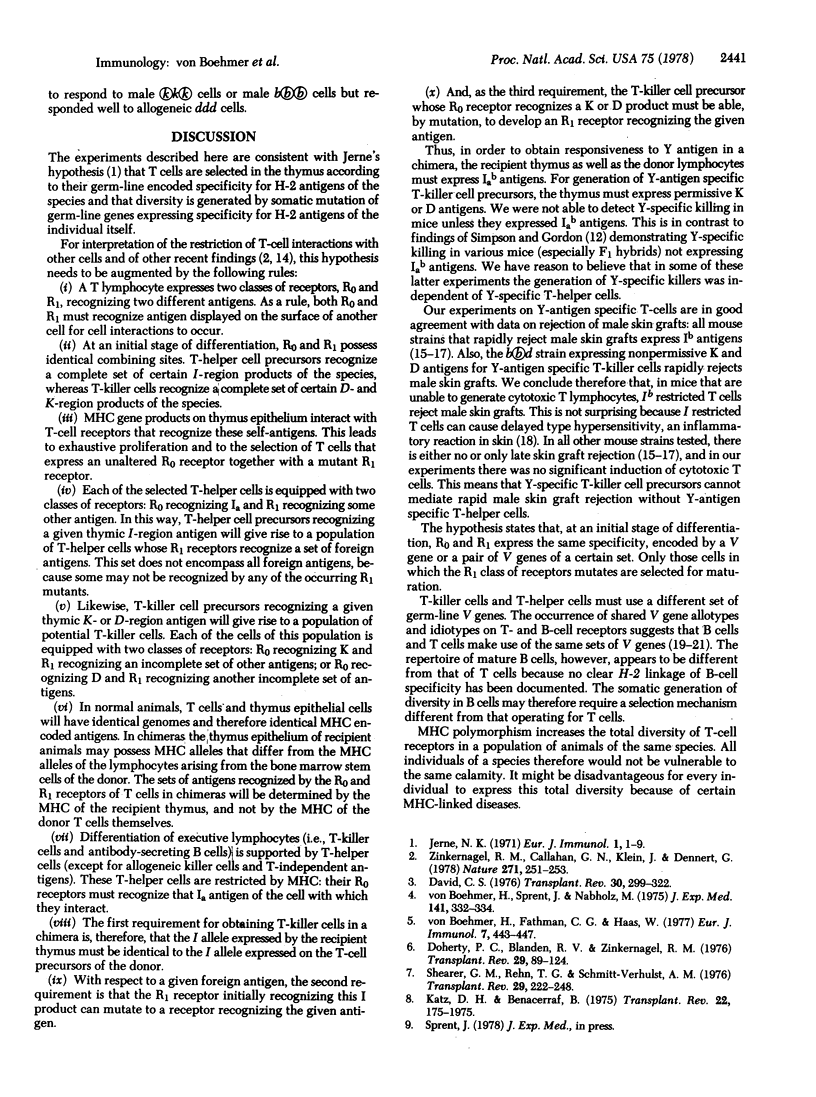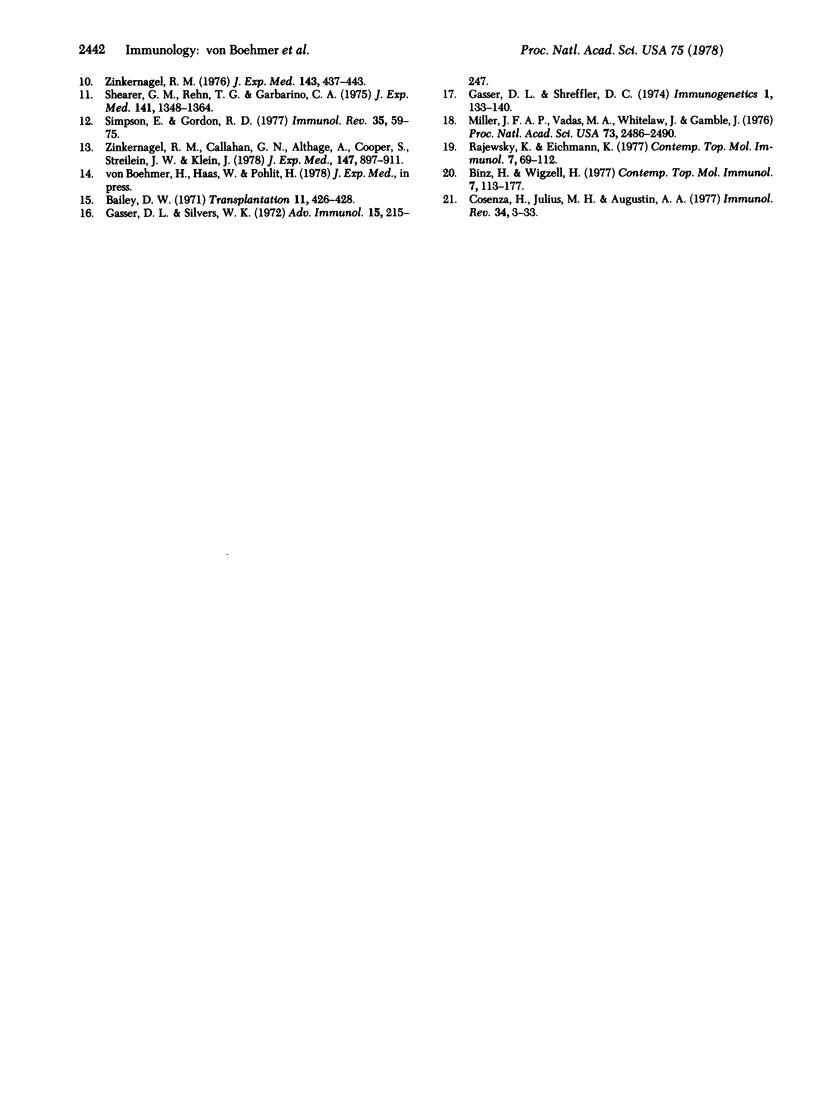Abstract
Female murine T cells can respond to the Y antigen of male cells by generating cytotoxic T-killer lymphocytes. Responsiveness is linked to several H-2 genes. Two types of low responders can be distinguished: the B10.A(5R) (H-2i5) strain, a low responder because it lacks Y-specific precursor T cells able to differentiate into cytotoxic T-killer cells; and the CBA/J (H-2k) strain, a low responder because it lacks Y-specific T-helper cells able to support differentiation of T-killer cell precursors. B10.A(5R) stem cells differentiating in an x-irradiated (CBA/J X C57BL/6) (H-2k X H-2b)F1 host respond to Y antigen by generating T-killer cells whereas CBA/J stem cells do not. The results are consistent with the hypothesis that diversity of T-cell receptors is generated by somatic mutation of germ-line genes encoding specificity for self-H-2. A detailed account of this hypothesis is presented.
Full text
PDF



Selected References
These references are in PubMed. This may not be the complete list of references from this article.
- Bailey D. W. Allelic forms of a gene controlling the female immune response to the male antigen in mice. Transplantation. 1971 Apr;11(4):426–428. doi: 10.1097/00007890-197104000-00017. [DOI] [PubMed] [Google Scholar]
- Binz H., Wigzell H. Antigen-binding, idiotypic T-lymphocyte receptors. Contemp Top Immunobiol. 1977;7:113–177. doi: 10.1007/978-1-4684-3054-7_4. [DOI] [PubMed] [Google Scholar]
- Boehmer H., Sprent J., Nabholz M. Tolerance to histocompatibility determinants in tetraparental bone marrow chimeras. J Exp Med. 1975 Feb 1;141(2):322–334. doi: 10.1084/jem.141.2.322. [DOI] [PMC free article] [PubMed] [Google Scholar]
- Cosenza H., Julius M. H., Augustin A. A. Idiotypes as variable region markers: analogies between receptors on phosphorylcholine-specific T and B lymphocytes. Immunol Rev. 1977;34:3–33. doi: 10.1111/j.1600-065x.1977.tb00366.x. [DOI] [PubMed] [Google Scholar]
- David C. S. Serologic and genetic aspects of murine Ia antigens. Transplant Rev. 1976;30:299–302. doi: 10.1111/j.1600-065x.1976.tb00224.x. [DOI] [PubMed] [Google Scholar]
- Doherty P. C., Blanden R. V., Zinkernagel R. M. Specificity of virus-immune effector T cells for H-2K or H-2D compatible interactions: implications for H-antigen diversity. Transplant Rev. 1976;29:89–124. doi: 10.1111/j.1600-065x.1976.tb00198.x. [DOI] [PubMed] [Google Scholar]
- Gasser D. L., Silvers W. K. Genetics and immunology of sex-linked antigens. Adv Immunol. 1972;15:215–247. doi: 10.1016/s0065-2776(08)60686-0. [DOI] [PubMed] [Google Scholar]
- Jerne N. K. The somatic generation of immune recognition. Eur J Immunol. 1971 Jan;1(1):1–9. doi: 10.1002/eji.1830010102. [DOI] [PubMed] [Google Scholar]
- Katz D. H., Benacerraf B. The function and interrelationships of T-cell receptors, Ir genes and other histocompatibility gene products. Transplant Rev. 1975;22:175–195. doi: 10.1111/j.1600-065x.1975.tb01559.x. [DOI] [PubMed] [Google Scholar]
- Miller J. F., Vadas M. A., Whitelaw A., Gamble J. Role of major histocompatibility complex gene products in delayed-type hypersensitivity. Proc Natl Acad Sci U S A. 1976 Jul;73(7):2486–2490. doi: 10.1073/pnas.73.7.2486. [DOI] [PMC free article] [PubMed] [Google Scholar]
- Rajewsky K., Eichmann K. Antigen receptors of T helper cells. Contemp Top Immunobiol. 1977;7:69–112. doi: 10.1007/978-1-4684-3054-7_3. [DOI] [PubMed] [Google Scholar]
- Shearer G. M., Rehn T. G., Garbarino C. A. Cell-mediated lympholysis of trinitrophenyl-modified autologous lymphocytes. Effector cell specificity to modified cell surface components controlled by H-2K and H-2D serological regions of the murine major histocompatibility complex. J Exp Med. 1975 Jun 1;141(6):1348–1364. doi: 10.1084/jem.141.6.1348. [DOI] [PMC free article] [PubMed] [Google Scholar]
- Shearer G. M., Rehn T. G., Schmitt-Verhulst A. M. Role of the murine major histocompatibility complex in the specificity of in vitro T-cell-mediated lympholysis against chemically-modified autologous lymphocytes. Transplant Rev. 1976;29:222–246. doi: 10.1111/j.1600-065x.1976.tb00203.x. [DOI] [PubMed] [Google Scholar]
- Simpson E., Gordon R. D. Responsiveness to HY antigen Ir gene complementation and target cell specificity. Immunol Rev. 1977;35:59–75. doi: 10.1111/j.1600-065x.1977.tb00235.x. [DOI] [PubMed] [Google Scholar]
- Zinkernagel R. M., Callahan G. N., Althage A., Cooper S., Streilein J. W., Klein J. The lymphoreticular system in triggering virus plus self-specific cytotoxic T cells: evidence for T help. J Exp Med. 1978 Mar 1;147(3):897–911. doi: 10.1084/jem.147.3.897. [DOI] [PMC free article] [PubMed] [Google Scholar]
- Zinkernagel R. M., Callahan G. N., Klein J., Dennert G. Cytotoxic T cells learn specificity for self H-2 during differentiation in the thymus. Nature. 1978 Jan 19;271(5642):251–253. doi: 10.1038/271251a0. [DOI] [PubMed] [Google Scholar]
- Zinkernagel R. M. H-2 compatibility requirement for virus-specific T-cell-mediated cytolysis. The H-2K structure involved is coded by a single cistron defined by H-2Kb mutant mice. J Exp Med. 1976 Feb 1;143(2):437–443. doi: 10.1084/jem.143.2.437. [DOI] [PMC free article] [PubMed] [Google Scholar]
- von Boehmer H., Fathman C. G., Haas W. H-2 gene complementation in cytotoxic T cell responses of female against male cells. Eur J Immunol. 1977 Jul;7(7):443–447. doi: 10.1002/eji.1830070708. [DOI] [PubMed] [Google Scholar]


